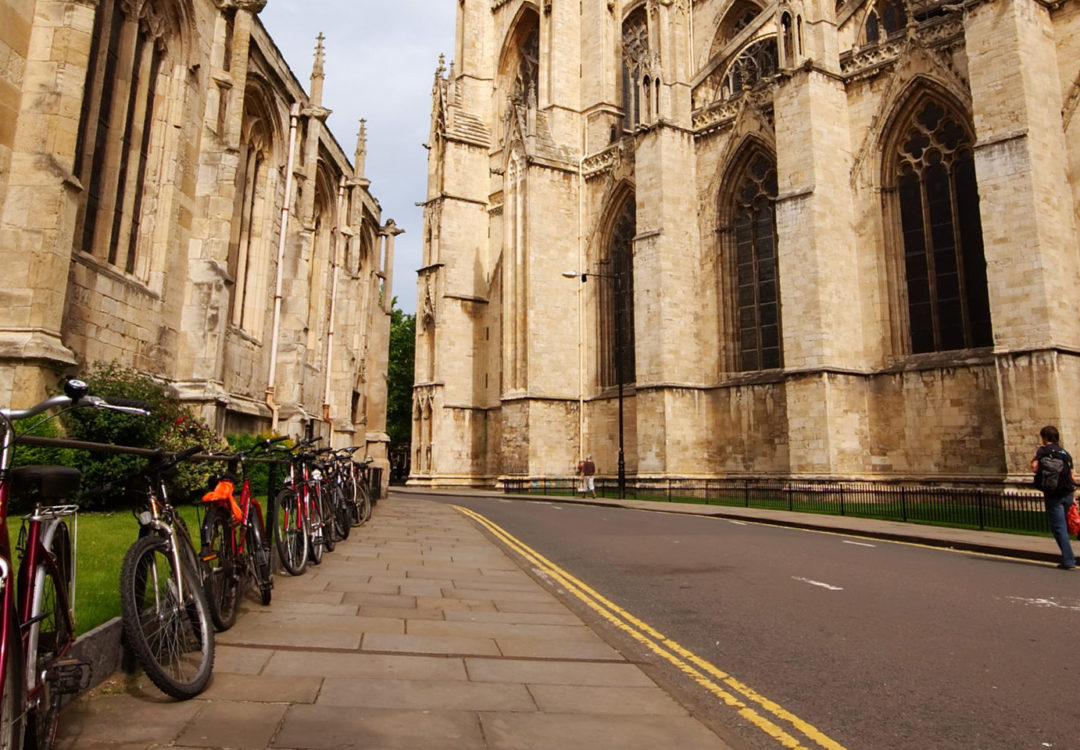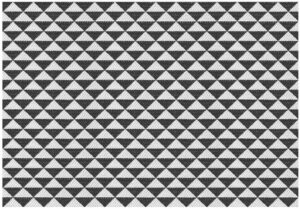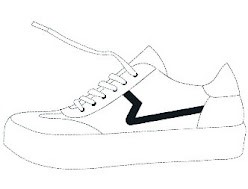Retail Scanner
Name that sign! Can a geometric sign be a badge of trade origin?
March 2024
In a nutshell, yes it can! As long as the sign itself functions as a trade mark and fulfils the basic criteria of being a source identifier and distinguishing goods from different undertakings. There have been a flurry of decisions in recent years on signs, especially on footwear, and whether they are distinctive enough to achieve trade mark protection. As everyone knows, having a trade mark is the ultimate protection symbol as it lasts indefinitely and importantly can be used to sue a competitor over an identical or similar sign!
We are going to take a look at a couple of key decisions, with the trend being another position trade mark decision for footwear, another decision in favour of the Applicant! It would appear that certainly for footwear, consumers very much buy from visual look and many trainer companies now adopt a form of silent luxury, in the sense of not having the main house brand on the trainers at all. However, as Prada found out, it doesn’t always go your way and there could be more of a differentiation between footwear and other fashion items!
PUMA succeed before EUIPO Board of Appeal over position trade mark
Back in October 2022, Puma sought to register the below sign for “footwear”:
The EUIPO examiner initially took the decision that “simple geometric signs such as circles, lines, rectangles or common pentagons cannot convey any message that will be remembered by consumers and will accordingly not be seen by them as a trade mark”. The examiner thought the above sign was too simple and had no other elements which would cross the threshold sufficiently enough for the mark to be seen as a badge of commercial origin to a consumer. So the examiner was fairly categoric in dismissing the above sign and thought it would be perceived as nothing more than two near parallel stripes.
Now Puma not unsurprisingly weren’t happy with that decision and who can blame them, especially given the context of the numerous Adidas three stripe cases and others. Trainers in particular are having a fashion moment!.
Puma filed an appeal and raised a number of interesting points:
- The relevant consumer is more observant when buying shoes. The relevant public is used to recognising the commercial origin of footwear based on signs placed on shoes
- Puma provided evidence of nearly 40 brands using figurative elements on the sides of shoes and are key to brand identification (e.g. Nike swoosh)
- Puma went into the sign itself and dismissed the analysis made, saying the sign at and is not merely two black stripes with curves. They argued the sign is memorable and distinctive and set out the accepted EUTM registrations for Class 25 of figurative signs, showing an inconsistency in office practice, in short it was too strict!
Puma were successful on appeal and it was agreed that the sign cannot be said to be devoid of any distinctive character. Even signs with a low degree of distinctiveness can be registered.
Some key snippets from the BOA:
“It is both well known, and indeed it has been amply demonstrated by the evidence filed by the applicant, that signs used on the sides of footwear enable consumers to differentiate and thus are not normally seen as mere decoration”
“the sign does not consist solely of a simple line or two but consists of at least a minimally distinctive shape”
“it cannot be said that the sign at stake is banal and merely consists of two parallel lines. It is immediately apparent that the lines are of different length, varying thickness, and that the space between them also widens as each curves downwards, with the result that the bottom of each line is significantly thicker than the top”
“not all kinds of stripes or lines would be seen as trade marks, but in this particular case the sign at hand does indeed have the minimum distinctive character”
Puma strongly convinced the Board of Appeal that the geometric sign would act as a source identifier in footwear sector and the evidence filed, especially of precedent cases, was very persuasive. The BOA doesn’t expect consumers to study the marks intensely but as with all trade marks, the sign will be remembered and has the threshold for distinctiveness.
Now for a different tale involving luxury fashion power house PRADA
The Second Board of Appeal of the EUIPO have rejected an EU trade mark application dating from April 2022 by Prada to register a repeating triangle device pattern (upside down isosceles triangle), as shown below
The application was filed for a very broad range of classes, so wasn’t restricted in the same way as the Puma case.
The initial examination report rejected the mark for being devoid of any distinctive character, notably because the EUIPO thought consumers would perceive the repeating pattern as a basic design and that it doesn’t convey any message that could attract the consumers attention and make the sign memorable at all.
In the decision, what becomes clear is that Prada didn’t appear to assert Article 7(3) which is acquired distinctiveness through use so the BOA had to disregard anything which applied to acquired distinctiveness as irrelevant. This does seem rather odd, as with most applications and indeed especially for marks of this nature, this would need to be in play as a ground to assert and fall back on if inherent distinctiveness is not possible.
The main grounds of appeal for Prada were the below, along with reference to the famous upside down isosceles triangle and how well know this is to Prada and they submitted evidence of books and advertising from the fashion house:
- The specific combination and particular arrangement in the EU pattern trade mark are not insignificant in terms of perception for the consumer and create a global impression that is sufficiently distinctive;
- Protection as a trade mark cannot be refused on a general ground that the sign contains only one regularly repeated element;
- Requesting that a pattern trade mark contains a verbal element in order to be registered goes against the law, as the presence of a verbal element in a pattern trade mark is not a condition of the validity of this type of trade mark.
The BOA ultimately partially rejected the application on inherent grounds, most notably for handbags and clothing. The BOA made a number of interesting points around how the mark itself will be applied to goods and how frequent and common this would be due the sign itself (e.g. whole handbag), which can be summarised as followed:
- “It cannot be considered that the pattern at issue differs significantly from the norm or customs of the sector” – thus a consumer not able to differentiate the source
- “Board notes straight away that the triangle-shaped pattern at issue is a basic and commonplace style of fabric or design…examiner cited several web pages where patterns where consisting of a combination of triangles were found on smartphone cases, shirts an bags”
- “the relevant consumers will not conceive the mark as a badge of trade origin, but merely as a decorative pattern of a style which is commonplace in the field of textiles”
It is to be noted that the Board made it very clear that Prada explicitly refrained from relying on evidence of use to succeed and so made it clear the decision was then on inherent distinctiveness only.
Overall the decision taken isn’t especially surprising. Clearly, Prada should be able to register the mark on the basis acquired distinctiveness through use and should have run that ground (unless we are missing something!), given the extensive evidence they would have to file and likely would be across the whole EU. But on an inherent level, the decision of the BOA is correct in my opinion and consistent with precedent.
It is to be noted that Prada does have other registrations in place to fall back on and it will be interesting to see if this particular mark is refiled or the decision further appealed.
So is it worth pursuing geometric signs only?
Yes! The majority of decisions coming out are in favour of the applicant (albeit mainly on appeal) and a further case involving Paredes Holding last year found the below mark also distinctive for footwear:
As long as the sign can be considered as performing the function of trade mark and acting as source identifier, then there are good chances for success. However what does seem to help is filing for a narrower range of goods such as footwear for example.
So, when looking at your portfolio and any new brands being created which are visible to the consumer and are distinctive, then it is worth trying to protect these signs also especially if they become a integral part of the brand and replace words. It is also always worth running the ground of acquired distinctiveness so do also keep evidence for submission to avoid a situation like Prada.

































